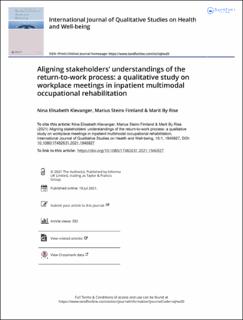| dc.contributor.author | Klevanger, Nina Elisabeth | |
| dc.contributor.author | Klevanger, Nina Elisabeth | |
| dc.contributor.author | Fimland, Marius Steiro | |
| dc.contributor.author | Rise, Marit By | |
| dc.date.accessioned | 2021-10-05T07:38:11Z | |
| dc.date.available | 2021-10-05T07:38:11Z | |
| dc.date.created | 2021-08-06T18:21:04Z | |
| dc.date.issued | 2021 | |
| dc.identifier.citation | International Journal of Qualitative Studies on Health and Well-being. 2021, 16 (1), 1-19. | en_US |
| dc.identifier.issn | 1748-2623 | |
| dc.identifier.uri | https://hdl.handle.net/11250/2787581 | |
| dc.description.abstract | Purpose: Although it is believed that involving the workplace and stakeholders in return-to-work interventions is beneficial, Norwegian occupational rehabilitation programmes rarely do. During 2015–2016, Hysnes Rehabilitation Centre provided inpatient multimodal occupational rehabilitation, including workplace meetings with employees, supervisors, and rehabilitation therapists. This study aims to explore the meetings´ content and stakeholders´ experiences.Methods: This was a multiple case study including non-participant observation of workplace meetings and interviews with participantsResults: Essential features of meetings included revealing and aligning the employee’s and supervisor’s understandings. Three components seemed instrumental in developing shared understandings leading to appropriate adjustments: 1) disclosing causes of absence, 2) validating difficulties, attitudes, and efforts, and 3) delimiting responsibility. Therapists played a vital role in addressing these components, supporting employees, and ensuring planning of appropriate solutions.Conclusion: Developing shared understandings by addressing and aligning illness- and return-to-work representations appears important for return-to-work interventions. Although pivotal to developing appropriate adjustments, disclosure depends upon supervisors’ display of understanding and should not be encouraged without knowledge of the employee´s work situation. How supervisors relate to employees and implement adjustments may be as important as the types of adjustments. The therapist’s support and validation of employees in vulnerable situations also seem valuable.Trial registration: The trial is registered at clinicaltrials.gov (NCT02541890), 4 September 2015. https://clinicaltrials.gov/ct2/show/NCT02541890. | en_US |
| dc.language.iso | eng | en_US |
| dc.publisher | Informa UK Limted | en_US |
| dc.rights | Navngivelse-Ikkekommersiell 4.0 Internasjonal | * |
| dc.rights.uri | http://creativecommons.org/licenses/by-nc/4.0/deed.no | * |
| dc.title | Aligning stakeholders’ understandings of the return-to-work process: a qualitative study on workplace meetings in inpatient multimodal occupational rehabilitation | en_US |
| dc.type | Peer reviewed | en_US |
| dc.type | Journal article | en_US |
| dc.description.version | publishedVersion | en_US |
| dc.source.pagenumber | 1-19 | en_US |
| dc.source.volume | 16 | en_US |
| dc.source.journal | International Journal of Qualitative Studies on Health and Well-being | en_US |
| dc.source.issue | 1 | en_US |
| dc.identifier.doi | 10.1080/17482631.2021.1946927 | |
| dc.identifier.cristin | 1924506 | |
| cristin.ispublished | true | |
| cristin.fulltext | original | |
| cristin.qualitycode | 1 | |

